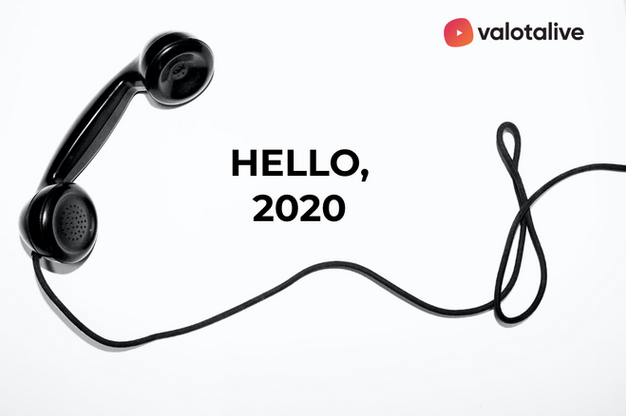How we communicate is constantly evolving
Effective communication is fundamental to success in both business and life. Its primary nature is also the reason it is often taken-for-granted. With a new year upon us, this article will focus on 5 emerging communication trends for businesses in 2020.
How we communicate is continuously evolving as technology improves and adapts. Therefore, it is important to reflect on how our communication can be more effective but also stay relevant. This is especially pertinent for businesses who hope to connect with their audience(s).
Each element explored below will be crucial to keeping your company and its communication strategies ahead of the curve.
Start the new year with a more mindful and calculated approach to ensuring effective communication. Read on to identify your potential next steps.
5 emerging communication trends for businesses in 2020
1. (More) Purposeful Content
People crave knowledge and the internet holds an infinite amount. Google’s immense power today is seen partly in its transformation into a verb. The information we can find online, however, is not always useful, accurate, or motivating to encourage further action. The internet is also laden with numerous advertisements and marketing ploys. Online consumers typically know when someone is only trying to sell them something.
Companies in recent years have taken steps to help remedy this by providing relevant, trustworthy, and informative content in their podcasts, blog posts, and other platforms.
Research from the Content Marketing Institute backs up these claims. They found 90% of the most successful businesses (in North America) prioritize their audience’s “informational needs” over the company’s sales and promotional messages in their B2B content marketing (see chart below).
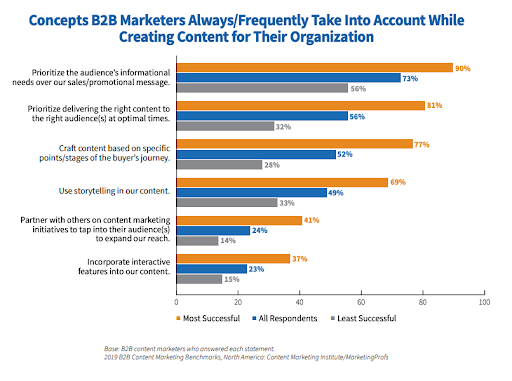
With more people creating high-quality, customer-first content online new and existing companies will in-turn need to improve their output. Well-crafted, purposeful content is key!
What is Needed: Research to gain a better understanding of your audience’s needs, better writing and deeper exploration into topics tailored to their needs, as well as more reputable, trustworthy sources linked within the writing.
2. Relevant and Timely Personalized Experiences
Personalization is not a new concept but its importance steadily increases with each new year. A company can have several different audiences that require unique customized content. To be able to provide relevant, informational content to customers and other businesses, companies need to know their audiences. They need to know not only the right information that serves a purpose for a given audience but also when it is the optimal time to provide it. As seen in the graph above, a whopping 81% of successful businesses place great importance on delivering relevant content to the appropriate audience at the right time.
This concept of personalization, in business terms, is instinctually linked to a company’s external communication. However, it is also crucial to remember that their staff are a crucial audience that would also benefit from personalized messaging. Greater personalization targeted to specific (groups of) employees and potentially allowing employees to have more control over the type and volume of messages received will help to improve internal communications.
This personalization (implemented thoughtfully and correctly) will be rewarded with a deeper relationship to the company from all audiences.
What is Needed: Sufficient research, implementing new, effective communication applications beyond email or other communication channels that aren’t working for your company, and optimizing the times when your audience/employees receive relevant information.
3. Visual Storytelling
Storytelling is the essence of human nature. The stories we tell ourselves, the stories we choose to listen to, and the stories we choose to share constantly creates and re-shapes our lived experiences. Businesses are not separate from this reality but rather willing participants in it. The graph provided above shows 69% of successful businesses use storytelling in their content.
“Story as it turns out, was crucial to our evolution – more so than opposable thumbs. Opposable thumbs let us hang on; stories told us what to hang on to.” (Lisa Cron, Wired for Story)
Writing has always been important to storytelling and will remain so but it is evident that visual media is increasingly more popular and prevalent every year, especially among young people. Visual media, particularly videos and images, catches and holds people’s attention more than the written word. Research by MDG Advertising highlights nearly two thirds of people consider themselves visual learners and are significantly more likely to look favorably upon ads that emphasize photography rather text.
According to a HubSpot report, a large majority of consumers (63%) insisted that they consumed video content more thoroughly while only skimming or multitasking written content and podcasts. 53% also indicated that they wanted to see more video content in the future (see chart below).
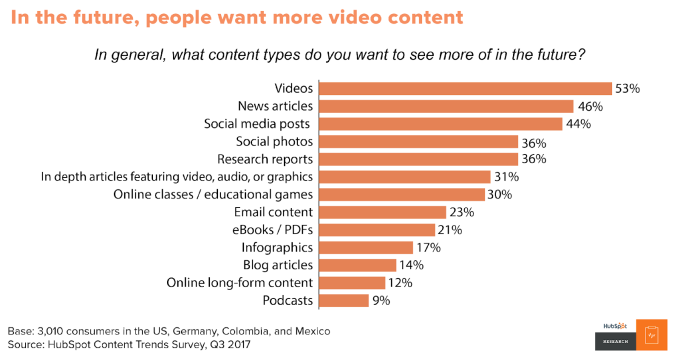
When you look at generational lines it is evident that age matters considerably in individuals’ content preferences. In the chart below, you can clearly see that younger generations strongly prefer video and desire more social content.
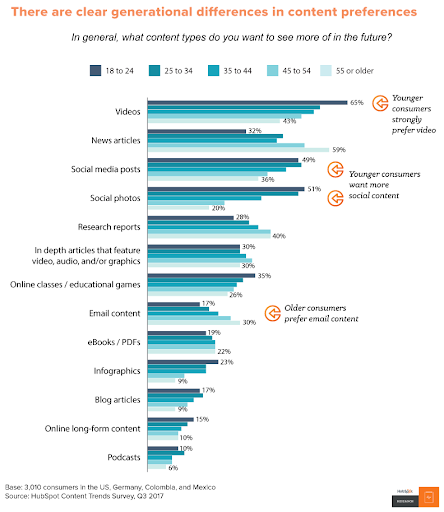
This does not mean that written content should now be abandoned but rather there should be a balance struck. It’s crucial to find the right ratio of different mediums, which factor in the ages of their target audiences. Additionally, quality matters. Anyone can create a video or take a photo but does yours tell a compelling story? Just like in writing, a poorly crafted video will not hold the audiences’ attention. Businesses must endeavor to engage audiences through all mediums.
What is Needed: Attempts to connect with your audience on a creative and emotional level through storytelling and increased focus on the creation of compelling and persuasive visual content (without neglecting written content)
4. Employee Advocacy
Employees play a key role in a company’s success, especially in an age of digital storytelling. Their reach and influence nowadays extends to much wider audiences through their social media networks. How they tell the story of their company can affect its bottom line.
A groundbreaking study in 2014 conducted by Weber Shandwick and KRC Research highlighted the emergence of employee activism with the rise of social media. One in five employees (21%) were identified as highly engaged employees who increased brand visibility and credibility and defended their company/organization, on and off the internet. Another 33% had the potential to do the same but employers were not effectively communicating to employees to promote greater engagement and (positive) activism.
It is important to note that employee activists are individuals that have the potential for both positive and negative actions against their employers. A more recent study by Weber Shandwick and KRC Research highlights that millennials, significantly more than other generations, see justification for employee activism even if it is against their employers (see chart below). They feel they have a voice to make a difference.
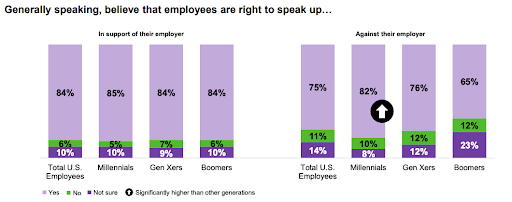
Employee advocacy is often expected to happen as a natural, unassisted process of an employee’s time at a company but this is ignoring an untapped resource by not actively supporting its development or attempting to mitigate negative criticism. Employee advocacy, however, cannot be forced or demanded. Companies have to inspire their employees to promote greater engagement. This requires aligning employees with company culture, building trust, and keeping employees informed.
What is Needed: Actively inspire employee advocacy through greater communication of the company’s missions and the employees’ role in fulfilling them as well as regular assessment of employees’ experience at work and their regard for the company.
5. Leadership Voice
There is increasing emphasis placed on employee engagement and interaction in communication channels, and rightly so, but there still is a vital need for strong, effective top-down communication. The goals of a company are bound to fail if the employees do not understand the strategies or trust leadership.
The most important element identified by Weber Shandwick and KRC Research (2014) to drive employee activism is leadership (see chart below). Effective leadership communication is imperative, if a company hopes to keep employees informed, inspired, and engaged.
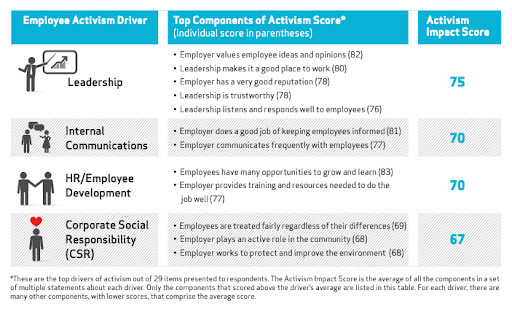
A clear and compelling leadership voice is an essential element in all internal communication strategies to help promote healthy relationships in the workplace, commitment to common goals, and greater collaboration. Leaders should be mindful of the strong impact they have on employee motivation and engagement, in both positive and negative ways.
What is Needed: Increased availability of important information, Employee alignment with company culture and strategic goals as well as clearer, more inclusive, and empowering communication that builds trust, promotes two-way conversations and collaborations, and prevents internal miscommunications.
Further reading you might find interesting:
Workplace Digital Signage for Employee Communications
Writer: Jade Rosenkranz is communications freelancer interested in building connections and storytelling.
Image Credit: Quino Al on Unsplash
